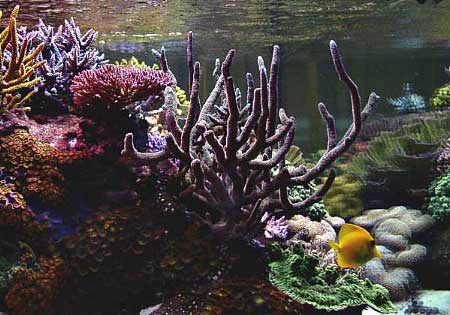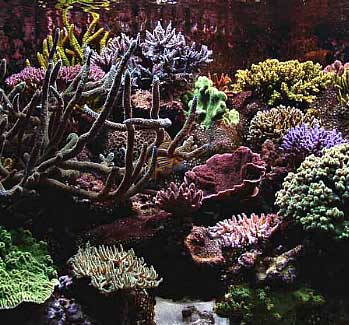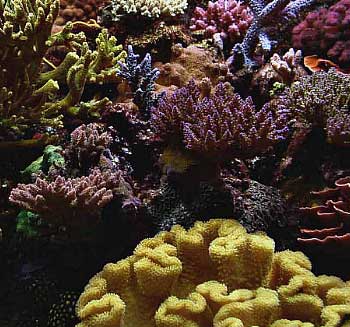|
George Rowe's (Eugene Reefer) Reef Aquarium
Introduction:
It would be an understatement to say that
Megan and I were surprised (stunned is probably a more accurate
description) when Skip e-mailed us several months ago, asking
if we would be willing to present our reef tank as a "Tank
of the Month" on Reef Central. Although we have kept
some sort of reef tank for a little more than six years, we
still consider ourselves relative beginners-that is, hobbyists
who too often continue to learn the hard way by making mistakes
that, in retrospect, could (and should) have been prevented.
It is thus a great honor-as well as a little daunting-to have
our tank included among the group of truly extraordinary tanks
that this forum has featured over the past several years.
 |
Like many in the hobby we began "small"-in
our case with a 30-gallon glass tank-after seeing what seemed
to us an unbelievably beautiful saltwater reef tank in a local
store in Eugene, Oregon. Although almost all of the information
we were given about setting up that first tank was wrong (inadequate
lights, a "Skilter" filter, and so on), we persevered,
read a lot of books, asked a lot of questions, and eventually
established a fairly successful soft coral tank. About a year
and a half later we upgraded to a 120-gallon acrylic tank
using metal halides (175-watt at first, later changing to
400-watt bulbs), VHO fluorescents, a sump, and an AquaMedic
Turboflotor skimmer. At that point, we began to try our hand
with SPS corals, and then gradually moved more and more in
that direction. Two years later we purchased and set up our
current tank, which is now about 2 ½ years old and
has suffered two serious setbacks: a four-day power outage
less than six months after it was established (we have since
bought a generator), and, more recently, an episode in which
I "burned" many of our SPS colonies by introducing
carbon for the first time in a ten-month period, thereby rapidly
increasing the intensity and/or spectrum of light penetrating
the water.
 |
 |
Here are some specs and details:
|
Aquarium
Profile:
|
|
Tank: approximately 340 gallon, all glass |
|
|
Sump:
60 gallons |
|
|
Stand
& Canopy: custom made |
|
Tank:
The tank is standard glass, manufactured
to our specifications for a very reasonable price by Sea Star
Aquarium Products, a small company located in Victoria, British
Columbia. It measures 96"L x 33"W x 24"H, and
has standard 5/8" glass sides and a 1" thick glass
bottom made from two ½" thick pieces laminated
together. It uses two overflows, each of which has two 1 ½"
drains. The overflows are placed 9" from each end of
the tank, and are shaped like trapezoids rather than rectangles.
Thus, the side panels of each overflow intersect the back
of the tank at a 45° angle. This makes them less noticeable
from the tank's sides. The total volume of the tank is 340
gallons. We also use a 60-gallon acrylic sump, which I made.
Although we don't have a refugium, we would like to install
one if we can find room for it.
Overall, we are very happy with the quality
and dimensions of the tank. Although the extra depth makes
it difficult to reach the back, especially in the middle,
where there is a 17" brace, it allows a great deal of
flexibility in aquascaping-a priority for us. If we did it
again, we would likely try to find a design that avoided using
such a large brace in the middle. Ideally, we would also have
access to the tank from the back, but because of our home's
floor plan arrangement, that is simply not possible.
Stand and Hood:
I built these myself. The main supports
for the stand are 2"x6" studs, which are sheathed
in alder. It is taller than many stands, since the tank's
bottom is 44" above the floor, and it has three doors
in the front and one at each end. The hood has three doors
and is built mostly of ¾" plywood, which I then
covered with an alder veneer.
Equipment:
The return pump is a Dolphin AquaSea 4700.
It feeds two modified 1" Sea Swirl return lines located
on the back of the tank. By my calculations, a bit more than
1500 gph flow through each of the Sea Swirls. Two Gemini pumps,
located in the rear corners of the tank, pump approximately
1000 gph each, for a total flow of 5000+ gph. We find the
motion created by the Sea Swirls very beneficial, and-until
recently-this has been enough flow for the tank. As the corals
continue to grow, however, we have begun to find some "dead
spots" and are thinking of adding more current, perhaps
by installing some sort of closed loop system.
Our skimmer is a Precision Marine Bullet
3, powered by an Iwaki 55RLT. We also have a very large MyReef
Calcium Reactor, with 8"x18" and 6"x18"
reactor tubes, as well as a MyReef Nilsen Reactor. Up until
about six months ago, we added calcium and raised alkalinity
with an MTC Pro-Cal, but that reactor, as terrific as it is,
eventually was unable to keep up with the tank's alkalinity
and calcium demands. We have been mostly pleased with all
of these items, although I have made a couple of modifications
to the MyReef calcium reactor. We also use carbon continuously.
There are five heaters in use on the system--all of them Ebo-Jager.
We have no pH monitor, ORP monitor, or any other controllers.
Lighting:
We use four 400 watt 20K Radium bulbs,
(over)driven by PFO HQI ballasts, and six 110 watt VHO bulbs
(four actinics and two Aquasuns), powered by both an IceCap
and an ARO ballast. The bulbs are arranged, from front to
back: actinic, Radium, actinic, and Aquasun. In the past we
have used both 65K and 10K 400-watt halides with two more
actinics, but, to our eyes, our present combination is the
best choice aesthetically. The corals may not grow as fast
with the Radiums as with, say, 65K bulbs (although ours certainly
seem to grow quickly enough), but at this point growth isn't
important to us; in fact, more often than not, it's a problem.
We replace all of the bulbs every six months at staggered
intervals.
Water Parameters:
The temperature hovers around 82° F
for most of the year and gets as high as 86° F during
the summer. We do use a small chiller to keep it from going
above 87° F. Our calcium level is typically around 420
ppm, and the alkalinity is usually about 10-12 dKH. I don't
check pH very often, but it is typically 8.1-8.3. Indeed,
I don't check many of these parameters very often any more.
We use no additives regularly, and make infrequent water changes.
About four gallons of water evaporates from the tank each
day. We use RO water, without a deionizer, for all top-off
and makeup water.
Aquascaping:
We tried to avoid as much as possible aquascaping
our "reef" to look like a solid wall. The 33"
width proved beneficial in this regard, since it gives the
tank a sense of depth that would be difficult to achieve in
a 24" wide tank. Our tank contains less live rock (approximately
300 lbs. total) than most other tanks its size, and we placed
much of the rock on a PVC frame, so that the entire left side
of the tank forms a large cavern in which the fish and other
critters can hide. We have also built several "canyons"
running front to back. Approximately 700 lbs. of sand cover
the tank's bottom-about two-thirds aragonite (mostly Southdown)
and one-third "Oregon Beach Sand," a silica based
sand that I purchased at a local garden supply (and which
has not caused any problems, despite some dire warnings).
The depth of the sand is quite low (1-2") at the front
and gradually rises to 8"+ in the back. This was not
our intention, although we like the effect quite a bit; in
this case, the Sea Swirls did the aquascaping for us. Similarly,
the presence of the large brown plating Montipora dominating
the back center of the tank resulted from our inability to
retrieve the 3" piece of that coral, which we had purchased
locally and placed in the back center "temporarily"
to see if it would brighten up. Well, it didn't, but by the
time we recognized that it would stay brown, we couldn't remove
it without breaking it. So we left it; it grew like the plant
in Little Shop of Horrors, and we have actually become
quite pleased with how well it fits into the overall arrangement
of the tank.
Maintenance:
The maintenance chores involve cleaning
the front glass every other day or so and occasionally making
sure the notches in the overflows stay as clear as possible
by removing some Bryopsis that tends to grow there.
The carbon is changed out roughly every six weeks, and the
skimmer is usually cleaned on a bi-weekly basis. I clean the
bottom of the 17" center brace about once per month with a
straight razor, as it tends to accumulate a thin haze, and
I also wipe the halides and VHO bulbs whenever they need it
due to salt spray build up. As I mentioned, we don't have
a strict regime of regular water changes, although we're hoping
to get into some sort of routine in the not too distant future,
possibly changing about 30 gallons per month.
Corals:
SPS corals dominate the tank, but it also
contains a fair number of various polyps and a couple of large
soft corals. We didn't introduce any of the polyps; they simply
appeared gradually as hitchhikers on the live rock we ordered
from Premium Aquatics for our 120-gallon tank-as did the large
Porites lobata adjacent to the Sea Swirl, on the right
as you face the tank. Most of the SPS corals started as fragments
or aquacultured corals, including the large Montipora capricornis
in the center (which is about 14" tall and 17" wide
and was even larger until I inadvertently broke off some of
its outer layers with a magnet) and the green staghorn next
to it. At this point, we have virtually run out of room in
the tank, so any coral we add must be balanced by removing
one.
Growth
Sequence #1:
Growth
Sequence #2:
Fish:
Currently, our tank is home to nine green
chromis, a three-striped damsel, a copperband butterfly, a
flame hawk, and three tangs (a purple, a yellow, and a clown).
The clown tang, which is very impressive but also extremely
territorial, is the dominant inhabitant, and his dominance
makes it difficult for us to add additional fish. We feed
somewhat heavily, alternating daily between spirulina, small
VibraGro pellets, and brine shrimp.
Invertebrates:
We have several brittle stars, quite a
few very small white Asterina sp. starfish (these have
only been around for the past year or so and they don't seem
to bother anything), lots of worms, assorted amphipods and
copepods in the sand, several conchs, and a mixed variety
of snails. We have only one hermit crab, since we stopped
adding them to the tank more than a year ago. There are, however,
lots of commensal crabs in the corals, as well as some very
large furry types, which we usually see only at night, and
which apparently came in to the tank as hitchhikers on the
live rock or corals.
That's all the information that comes to
mind at the moment. Thanks again to Skip and the Reef Central
crew for graciously featuring our reef tank. I'll be happy
to answer any questions, either on the board or through email.
Feel free to comment or
ask questions about my tank in the Tank of the Month thread
on Reef Central.
|

